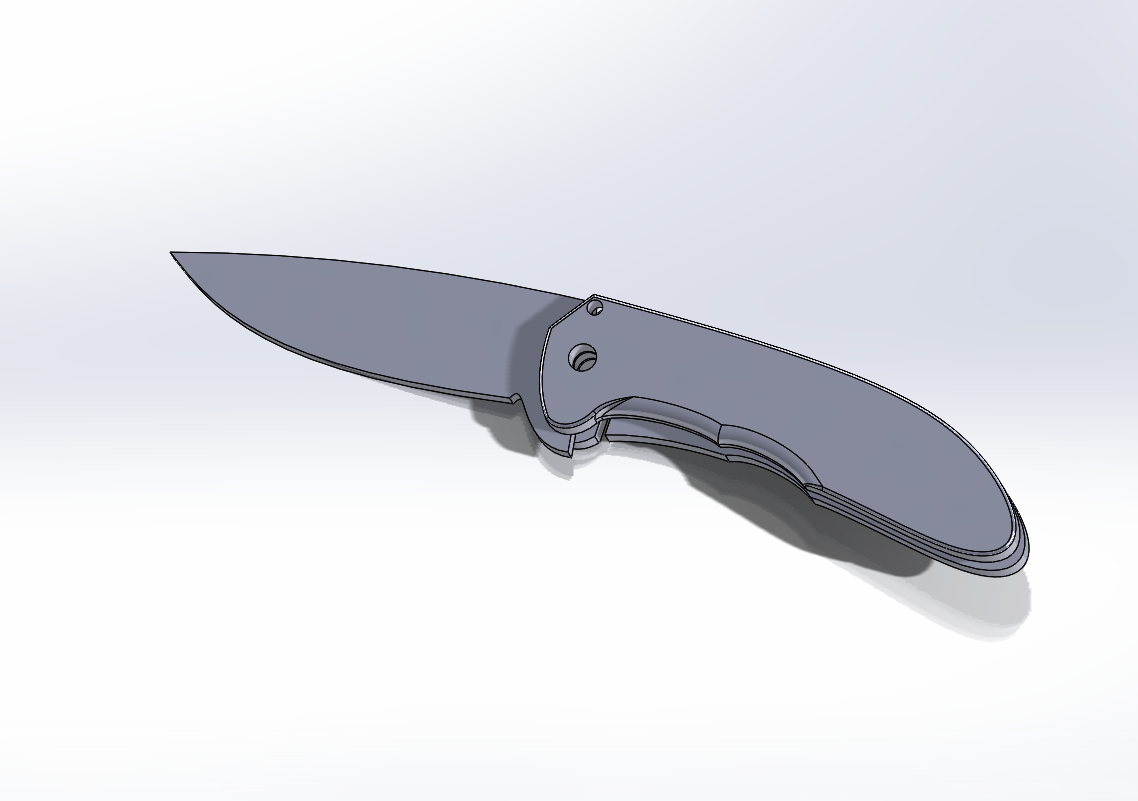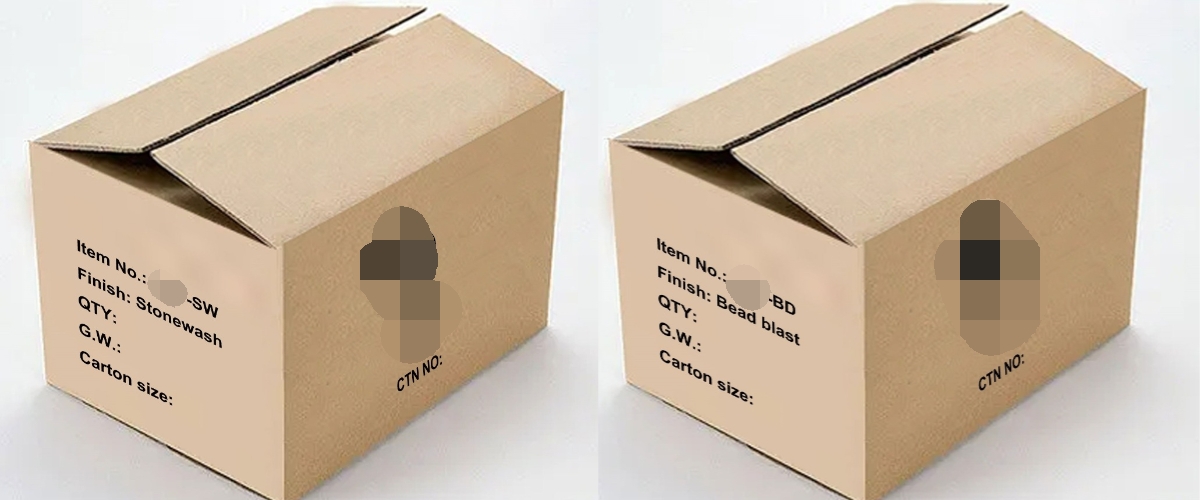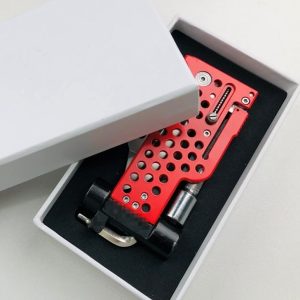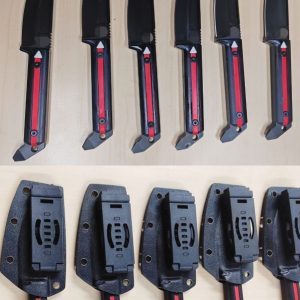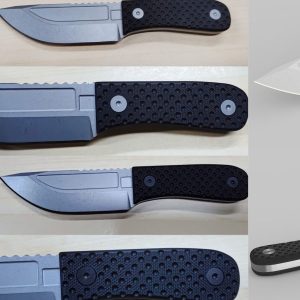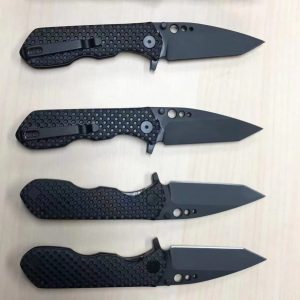Parte 1 – Panoramica del progetto
Tempi di consegna
The project was extended due to a couple of factors. Firstly, at the customer’s request, a three-month testing and promotion period was implemented for the prototypes under their new brand. Secondly, there was an issue with the raw material, resulting in a switch from M390 to CPM-20CV for the blade material.
However, the Shieldon team addressed all challenges and maintained seamless communication with the customer through email and video chat.
The entire process, from start to finish, serves as an informative OEM textbook, highlighting the significance of effective communication and problem-solving in the manufacturing industry.
Come è nato il progetto
The customer, a new player in the knife market, was on the lookout for a trusted OEM manufacturer in China. Upon discovering Shieldon on our website and assessing our production capabilities, they confidently chose us for their OEM knife needs.
As their dedicated supplier, we provided comprehensive services that covered production and shipping.
Together, Shieldon and our valued customers in the knife market venture on a new chapter, showcasing a seamless partnership.
Custom review
Check out this customer review of our OEM premium knife, Jersey, manufactured by Shieldon. The customer was satisfied with their experience, highlighting the exceptional quality of the knife.
This case proves that Shieldon excels at creating high-quality folding knives that make a lasting impact in the market.
With meticulous attention to detail and unmatched craftsmanship, Shieldon continues to exceed customer expectations and establish itself as an industry leader.
Parte 2 – Motivo per cui il cliente ci ha scelto
We provided design sketches and rendered images
With over 20 years of experience, Shieldon is a trusted OEM manufacturer that understands the challenges customers face when searching for a reliable supplier. We ensure model quality by rendering images, structural images, and vital data.
Our expertise in knives and tools is showcased through comprehensive email communication, including images, techniques, video clips, and CAD drawings. Equipped with state-of-the-art equipment and extensive industrial resources, we solve production problems related to outdoor knives and tools.
Each OEM project has unique requirements, and our goal is to understand and fulfill your needs. Contact us today to embark on a successful partnership.
Shieldon supplied packaging
Shieldon offers more than just outdoor knives and tools. They provide comprehensive trading services that go beyond workshop production, including packaging design and material making. With a partnership factory in the industrial zone, Shieldon assists customers with all their packaging needs.
They are trusted by many customers for branded box-making, ensuring a focus on quality and eliminating worries about packaging. Shieldon recognizes the importance of packaging as a marketing strategy, creating well-designed packages that not only protect goods but also make a positive impression on consumers.
They even offer innovative ideas like including instruction papers in the lid-and-base box. With a dedicated team, Shieldon carefully crafts content and incorporates customer signatures to contribute to their future success.
We supply the certificate of exported steel
Shieldon offers a wide range of steel options, both domestic and international, for OEM/ODM customers. They provide certificates to confirm the steel selected by the customer, ensuring accuracy in production.
With over 20 years of experience, Shieldon has a mature supply chain and can meet all customer requirements efficiently.
We supplied quality checking process
We provide photos and videos of the production process to keep customers informed about our activities and project progress. Capturing the entire production process takes time, and uncertainties may arise.
We appreciate our customers’ understanding and acceptance during the extended production period. Check out the attached photo for a glimpse of the semi-finished Titanium backspacer, handle scales, clip, and CPM-20CV blade.
We also send quality assurance videos to ensure customers understand our work and project progress.
Forniamo spedizioni internazionali
Foreign trade is a complex process that involves long-distance shipping and international customs clearance. It requires careful documentation and submitting applications to both governments.
But don’t worry, Shieldon has got you covered with over 20 years of experience in the foreign trade industry. We take care of every little detail to ensure a smooth and stress-free experience for our valued clients.
We supply social media promotion
Shieldon dominates social media platforms including Facebook, Instagram, YouTube, and TikTok. Among these, Instagram stands out as the most proactive platform with a substantial following. We assist our customers in promoting their brands and products with their consent.
Our goal is to ensure our OEM customers achieve significant sales and repeatedly request additional orders. This mutually beneficial approach benefits both parties. For more information, feel free to follow our Instagram page at https://www.instagram.com/shieldon_knives/.
Parte 3 – Storia del processo di produzione
1) Initially, the customer provided a simple DXF file from SolidWorks, showing a basic blade and handle. From there, we relied on our expertise and creativity to bring the entire knife to life. It was both exhilarating and challenging. Rest assured, if you trust Shieldon, we will deliver an exceptional OEM item tailored to your specifications. Just let us know the additional production components you need, and we will bring your vision to reality.
2) After a video meeting and email discussions, we gained a basic understanding of the customer’s knife requirements. Using the blade’s features and one side of the handle, we created a simple 3D drawing for their review. Please note that this drawing is still in progress.
As mentioned before, OEM projects require continuous communication for mutual understanding. We won’t proceed until the customer confirms every detail, as any mistakes could cause delays. With OEM projects, we leverage our expertise while considering the customer’s unique specifications.
3) When working on an Progetto dell'OEM, customers often have lots of questions during the 3D rendering process. To make it easier to understand, we usually show examples with photos to explain things better when we communicate online. In this academic article, we’ve put together a collection of questions and answers that shed light on the common challenges faced in OEM projects. These examples will help you grasp the complexities of these efforts and gain valuable insights.
4) We offer a wide range of popular blade finishes in the knife market, including satin, stonewash, bead blasted, titanium coating, DLC, acid etched, and even 3D printing. Our customer chose a combination of half stonewash and half bead blasted finishes. For high-end budget knives, we provide G10/Micarta, while premium ones feature 6AL4V Titanium. Our selection of high-quality clips includes stainless steel, wire, and milled titanium. The customer opted for a custom-milled titanium clip to match their knife’s appearance. Explore our durable and stylish options to enhance functionality and aesthetics. Contact us for personalized designs and exceptional quality.
5) We provided a variety of options for the lock mechanism and the blade material. For the lock, we showed the customer a frame lock example, which they decided to use. As for the blade material, we offer a wide range of domestic to international steels, and the customer eventually chose M390 and CPM-20CV.
6) When it came to the backspacer and clip screw, we guided the customer on what would suit their knife. We proposed a milled Titanium backspacer and a T6 or T8 size for the clip screw. To simplify assembly, we recommended using the same type of screw throughout the knife, which only requires one screwdriver for (re)assembly.
7) For the blade grind and pivot, the customer chose a flat grind—popular for daily EDC folding knives—and a caged ceramic ball bearing for assembly, which we helped them decide. We also suggested using T8 screws for all parts of the knife, from pivot to body to clip, to maintain uniformity. We emphasized using 416 stainless steel for its excellent heat treatment attributes, ensuring durability and strength.
8) We’re equipped to make modifications to the pivot by implementing a D-shape design, which will effectively prevent it from spinning during use. Furthermore, we provide personalization options such as engraving onto the knife. This could be the name of the steel, a logo, or any specific text that the client wishes to have on their product. Additionally, we extend our services beyond just the creation of the knife. We also assist in the development of packaging and handle international shipping, ensuring your product reaches you no matter where you’re located globally.
9)The customer found our responses to their inquiries quite relieving, and they appreciated our professional approach. They had a few more questions about the production process, which we’ll cover later. During the 3D rendering drawing phase, we had extensive discussions to finalize every aspect of the knife’s design. For instance, the customer wanted to eliminate the concave on the lock bar, as shown in the photo.
10) We shared the final image of the structure with the customer, impressing them with our ability to create a complete knife based on their blade and handle features. Our design included skeletonized handles and hidden lock sticks, showcasing our professionalism. Some minor adjustments were made before proceeding to prototyping. All data needed to be finalized at this stage, as no changes could be made once machining began.
11) The customer reviewed the adjusted structural image and inquired about the minimum order quantity (MOQ) and prototyping process. For a knife with a titanium handle and premium blade, the MOQ is 150 pieces, with the price per unit decreasing for larger orders. 8 prototypes are produced within 35 days, with 6 sent to the customer and 2 kept as references. 5Cr steel is used for prototyping to save costs. With specific prices from the quote, the customer can estimate the retail price in their market.
12) The customer requested an improved pivot appearance for the rendered images. We added a milling circle and designed a handle scale with contouring for a comfortable grip. After a thorough review and confirmation, the customer made the payment through Alibaba. With the prototyping fee received, we started creating the prototype promptly.
13) We shaped our customer’s knife, named ‘Jersey’, with care. We shared early images of the blade and handle, highlighting the raw steel and titanium. These pictures helped them envision their product, while the carefully crafted jimping on the blade added both function and style. With our expertise, we paid attention to every detail, even without specific requirements.
14) We believe in transparency, so we offered the customer a behind-the-scenes look at the prototyping process through a video. With our two-decades-long heritage based in Yangjiang, China, we take pride in our comprehensive manufacturing capabilities and willingly showcase our process, provided no confidential information is disclosed.
15) Once all the components were ready, we assembled the prototypes. Prototyping is a vital step in our process, as it allows us to test the product’s functionality before mass production. In this case, our customer requested a series number on the backspacer of the knife. We obliged and provided them with photographic proof of execution.
16) Prototyping is a crucial step in the manufacturing process, as it brings the product to life and allows for early marketing. In the case of ‘Jersey’, collaborative work with the customer resulted in an engraved logo on the show side pivot screw. Six prototypes were produced, offering a choice of finishes for the blade. This variety helped the customer decide on the final look that complemented the handle scales.
17) After prototyping, we received valuable feedback from the customer on six models. The feedback covered various aspects, including upgrading the clip, adjusting the engraving location, modifying the body screws, and maintaining the handle scales contour. Additionally, pricing for a 300-piece order with different finishes was discussed.
18) Additional feedback received from the customer included: adapting the internal milling to maintain weight and improve balance, and discussing the final packaging. Adjustments were made accordingly.
19) Based on the feedback, we improved our structural design and shared it with the customer. This detailed structure helped our customer understand the knife’s construction. We then updated the quote to reflect the increase in order quantity to 300 pieces and the discussed modifications. It’s crucial to keep track of all changes to avoid future confusion.
20) We shared photos from our workshop, giving a glimpse into our production process. Although it may appear chaotic, this is a natural environment for production. We utilized CNC machining, a technique involving pre-programmed software guiding factory machinery, ensuring each component matches the confirmed structural data. This process showcased our modern equipment and technological capabilities. Our production process is overseen by a management team to ensure quality and efficiency.
21) This image showcases the backside of the knife handle scale, which perfectly matches our previously shared structural image. Key features include an externally milled circle hole around the pivot per the customer’s request, an uncut lock bar spring, and internal surface milling providing space for a lock stick, which increases durability by preventing titanium-to-blade contact.
22) The image here reveals the show-side of the handle scale, which has been modified based on customer feedback from the prototype. The internal surface has two skeletonized holes, a reduction from three, which helps to shift the balance point towards the pivot.
23) Our skilled team has precisely milled both sides of the handle scale. After confirming the CAD data, we transitioned to wire-cutting the lock bar and bead-blasting the scales. Special care is taken to avoid scratches on finished components, as we strive to deliver perfect premium knives to our customers.
24) The image depicts the backspacer, freshly cut from raw titanium. It’s still subject to CNC machining and final polishing. Knife making is a gradual process, evolving from raw material to finished product. It’s worth noting that while knife making isn’t a get-rich-quick scheme, it is a rewarding hobby with a global market value of $3.81 billion in 2021, projected to grow annually by 6.0% until 2030.
25) The final image displays a completed titanium milled clip. Swapping the prototype’s acciaio inossidabile clip for a titanium one in mass production resulted in a more comfortable and stylish grip. The clip complements the knife’s overall aesthetics, especially when clipped in a pocket. To enhance visual harmony, we finished the clip in the same two styles as the blade – stonewash and bead blasted.
26) Presented here is a photo featuring our M390 steel knife blade, captured after undergoing heat treatment and CNC machining. Although the blade has yet to be sharpened, it showcases a distinct sharpening notch and plunge line, precisely as requested by our customer. We believe that the blade serves as the heart of the knife, particularly in the case of a folding model. At Shieldon, we handle these blades with utmost care.
27) A video is included here that exhibits the polished M390 blade. We carefully examined and strategically arranged the blades for future assembly. Our customer requested a certificate and HRC testing result, which are vital to confirm the authenticity of the materials we use at Shieldon.
28) This portion shows the HRC testing for the M390 blade, with the HRC averaging around 60.5, which is typical for M390 blades. However, we detected a minor issue with this batch of blades during our routine quality control check. After a thorough investigation, we discovered a physical defect in the blade, traced back to the raw material steel.
29) If you’re a knife enthusiast or collector without manufacturing experience, the issue we detected might be challenging to comprehend. In simpler terms, the HRC testing revealed inconsistencies, fluctuating between 58 and 62. We suspected impurities in the raw material steel, which was confirmed upon closer inspection. This unfortunate situation was traced back to our supplier, who inadvertently supplied us with M390 molding steel instead of plate steel.
30) A video is available to provide a visual explanation of the issue. When it comes to steel, molding steel has a higher impurity content compared to plate steel. This becomes apparent after heat treatment, resulting in small hollow gaps in the steel. These minute hollow spots become noticeable on the surface of the blade following CNC milling and polishing.
31) We noticed imperfections on the M390 blade during the final checks. Although this led to a delay in production after informing the customer, we assured them of a solution. We proposed using CPM-20CV steel, which has nearly identical properties to M390 steel, but from a different manufacturer. We reassured the customer and moved on to rectify the situation.
32) After purchasing the CPM-20CV steel, we provide a video showing the raw plate steel, with a thickness ranging between 3.3 to 3.4mm.
33) To ease customer worries, we gave them a thorough breakdown of M390 and CPM-20CV. We made sure to let them know that the quality and cost are pretty much the same. And to catch up on lost time, we jumped right into wire cutting.
34) We posted a video showcasing the wire-cutting process on CPM-20CV steel to boost your confidence in our crisis management skills. It’s not unusual to encounter such challenges in the industry but rest assured, we have the expertise to handle them.
35) After CNC machining and polishing, we proceeded to blast the blades. Shieldon proudly showcased a photo of the blade in its flawless state after the bead-blasting process. Our experts also explained the additional material at the tip of the blade, which is a common industry practice used to protect it during the manufacturing process. Lastly, we get into the details of the bead blasting process and its impact on the final finish of the blade.
36) Have you ever wondered how a bead blasting process works? We’ve filmed a video for you to show the process. It involves high-pressure blasting of small beads against the blade surface.
37) The customer requested two finishes: bead blasted and stonewashed. Can you see the differences in the photos? The stonewashed finish gives the blade a rustic yet refined look with acid etching for added character. In contrast, the bead-blasted finish creates a dark grey appearance, hiding scratches and reducing reflectivity. Each finish has its advantages: stonewashed is more durable, while bead blasting enhances surface hardness and aesthetics.
38) Afterwards, we meticulously count and arrange the CPM-20CV blades, which are made of a valuable material. This responsibility falls under the purview of our Product Management Center (PMC) department.
39) Crafted with precision, the knife body is meticulously assembled from raw titanium parts. Our Jersey knife boasts five intricately milled titanium components: the blade, handle scales, backspacer, and clip. These 23 distinct processes demand specialized skills and significant time investment to bring this exceptional knife to life.
40) Before engraving the series number and steel name beneath the backspacer, we needed to ensure the format and placement were correct. Engraving is a permanent process, so we wanted to confirm everything beforehand. To assist with this, we shared a sample image illustrating the engraving area for the customer’s approval. The series numbers spanned from “001/150” to “150/150”.
41) Here’s a quick look at the engraved backspaces. Once a number is etched onto the steel, it remains permanent. With over two decades of experience in OEM projects, we pay attention to every detail. We keep our customers informed at every step, ensuring they understand the production process and principles. It’s a learning journey for everyone involved.
42) In this video snippet, you’ll notice that all pivot screws are engraved with the logo. This method is a cost-effective alternative to creating custom pivot screws. Any custom logo can be featured on the flathead 416SS screw. After engraving, the screws are coated with anti-rust oil for protection.
43) Flathead pivot screws usually come in two sizes: 8mm and 10mm in diameter. The size you choose depends on the knife’s size. For our Jersey model, which has a larger handle, we opted for the 10mm screw. This allows the customer’s “spade” logo to fit perfectly.
44) The attached photo showcases the handle scales, which have been finished with bead blasting and a neatly cut lock bar. Bead blasting is a technique commonly used in the knife industry to create a protective layer against scratches on titanium. This preserves the premium quality of the material, which is both soft and highly sought after.
45) We meticulously bent the lock bar to achieve the perfect angle, ensuring a secure blade lock when opened. On the show side, we streamlined the assembly with a ceramic ball bearing, pivot screw, and two body screws held in place by a standoff. This showcases Shieldon’s exceptional production and assembly workflow, exemplifying our commitment to professional workshop management.
46) In this part of the process, we focus on assembling one side of the knife first, and arranging the components neatly. Our expert then fits the blade and fine-tunes the detent.
47) The blades, with both stonewash and bead-blasted finishes, were prepared and sorted in separate trays for easy counting. The assembly step is crucial and requires careful management. Shieldon may not mirror the spotless environment of some large manufacturers, yet we uphold stringent inspection standards and maintain professionalism, despite a casual atmosphere.
48) This section provides insight into how our technicians assemble each Jersey knife piece. Although the work table may seem cluttered, it contains all the necessary assembly tools and accessories. We believe in showcasing authentic working environments, rather than overly clean and staged setups. While we can’t reveal all assembly processes due to confidentiality, please be assured that every Jersey piece is assembled with utmost care.
49) Our Quality Assurance (QA) team inspects every blade individually, identifying any issues with the detent or lock mechanism for reassembly. It’s crucial to scrutinize everything thoroughly before packaging. Our QA team operates independently of the workshop, adopting a market-oriented perspective to better understand consumers and ensure a critical inspection approach.
50) Check out this video segment showcasing our meticulous QA inspection work. Our Jerseys are flawlessly assembled, with a perfect blade and handle fit, smooth detent, and a solid lock. They’ve been cleaned, packed, and are all set for shipping.
51) The first photo showcases the front side of the Jersey knife, also known as the show side, mark side, or front side. It’s like the face of a person you interact with, displaying logos and the most attractive details. From this side, you can also see the pivot, which is the heart of a folding knife, and the blade. The Jersey knife starts as a 2D graphic line on solid work and goes through 23 manufacturing steps to become a unique design. This includes engraving the client’s logo on the pivot screw. This example highlights Shieldon’s expertise in Coltello OEM and tool production, handling projects from 3D drawing to prototyping, mass production, and shipping.
52) The following photo reveals the backside of the Jersey, also known as the pile side or reverse side. This side serves a functional purpose and accommodates features such as the pocket clip and lock bar. The lock bar, shaped like a “7”, ensures the blade remains securely open. Each knife is assembled manually, requiring skill to maintain consistent lock bar power. Despite this challenge, Shieldon guarantees the quality of all its products, establishing itself as a reliable OEM supplier for your knife business.
53) The included video offers a concise demonstration of the assembly process for the Jersey knife. While the recording was intentionally brief to minimize disruption to the technician, it effectively showcases Shieldon’s expertise in knife production, serving as a testament to their professionalism.
54) A different video demonstrates the impeccable detent action of the Jersey knife throughout its opening and closing. This serves as a prime example of Shieldon’s exceptional expertise in crafting and assembling knives, irrespective of the lock mechanism, thereby enhancing our reputation in the OEM knife and tool market.
55) In addition to producing the Jersey knife, Shieldon provided valuable support to the client by assisting with the package design. Despite initially unclear instructions, our skilled graphic designer successfully brought the customer’s vision to life, creating a tangible product. We offered a wide range of materials to spark inspiration throughout the design process.
56) The design process for the packaging box required a step-by-step approach due to a lack of initial ideas. We used brand establishment knowledge to guide the customer in finalizing the packaging idea. We took inspiration from their brand logo (a spade) and their brand’s Instagram color scheme (black and white). Given the high-quality materials of the Jersey knife, we chose a premium lid-and-base box with an EVA tray for protection during shipping.
57) Creating a prototype for the box took 15 days, while mass production required 30 days. We urged the customer to quickly approve every detail of the box. We also insisted on the inclusion of an instruction paper in the box.
58) We concluded that the packaging materials should include a lid-and-base box, an EVA foam tray shaped like the Jersey knife, a PP bag for knife protection, a business card-sized instruction paper, a label to distinguish between stonewash and bead blasted versions and a protective film wrapper around the box.
59) We made a two-sided business card-sized instruction paper. On one side, we placed the image of the Jersey along with the designer’s signature, and on the other side, we listed the specifications of the Jersey knife. We took care to differentiate between the two versions of the Jersey.
60) We also made stickers for customers to differentiate between the two versions. Suggestions for additional packaging materials, like a nylon pouch and a knife cloth, were considered but not chosen due to cost and potential misrepresentation. This packaging solution delighted customers, showing Shieldon’s commitment to knives and international relations.
61) To comply with international logistics regulations, we assisted in the production of the carton. While carton making was not challenging, we learned that certain words like “knife”, “folder”, and “hunting” should not be visible on the box surface. Failure to adhere to this guideline may result in customs confiscating the goods, as they could be mistaken for weapons.
Spedizione e riepilogo
1) Once the Jersey knives are prepared and thoroughly reviewed, they are cleaned, packed as per custom guidelines, and scheduled for shipment. The tracking number is shared with the customer as soon as it becomes available. We ensure that all international shipping protocols, including document submission and applications, are meticulously followed.
2) The attached image showcases how we attentively wipe down the surface of every Jersey knife before it’s placed in a transparent plastic bag for packaging. Any requested spare parts, like pivot screws or caged ceramic ball bearings, are usually not shipped with the knife, as we strive to deliver a perfect product that doesn’t require any adjustments.
3) Included is a video clip demonstrating our diligent cleaning process for each knife. Using anti-rust oil, we ensure long-term corrosion prevention. We treat these knives as valuable products crafted within the Shieldon factory.
4) After cleaning, the Jersey knives are packed into the brand-specific box for dispatch. We also implement protective measures to safeguard the product during long-distance transit. With Shieldon handling all production tasks, our customers can concentrate solely on their brand growth and marketing tactics.
5) Finally, visit the customer’s website to explore the Jersey knife in detail, or tap into exciting content on Shieldon’s social media channels, ranging from Facebook and Instagram to YouTube, TikTok, Twitter, Tumblr, LinkedIn, and Pinterest. Stay tuned for our next educational showcase.










